Global Thrombectomy Devices Market, By Type, By Application, By End User, By Region & Segmental Insights Trends and Forecast, 2024 – 2034
- Industry: Healthcare
- Report ID: TNR-110-1232
- Number of Pages: 420
- Table/Charts : Yes
- July, 2024
- Base Year : 2024
- No. of Companies : 10+
- No. of Countries : 29
- Views : 10118
- Covid Impact Covered: Yes
- War Impact Covered: Yes
- Formats : PDF, Excel, PPT
Thrombectomy devices are medical instruments designed to remove thrombi (blood clots) from blood vessels. These devices are essential in treating various thromboembolic conditions, which can cause serious health issues such as stroke, deep vein thrombosis (DVT), and pulmonary embolism. By removing the clot, these devices help restore normal blood flow, thereby preventing tissue damage and other complications.
The thrombectomy devices market is poised for significant growth, driven by increasing incidences of thromboembolic diseases such as stroke, DVT, and pulmonary embolism. Advancements in minimally invasive technologies and the rising demand for effective, rapid treatments are key growth drivers. Opportunities abound in emerging markets with improving healthcare infrastructure and growing awareness of thrombectomy procedures.
Trends include the integration of AI and robotics for enhanced precision, the development of portable and user-friendly devices, and a surge in R&D for innovative solutions. Favorable reimbursement policies and an aging global population further propel market expansion. This dynamic market offers substantial potential for stakeholders to capitalize on the evolving landscape of thromboembolic treatment. In Terms of Revenue, the Global Thrombectomy Devices Market was Worth US$ 2.3 Bn in 2023, Anticipated to Witness CAGR of 8.3% During 2024 – 2034.
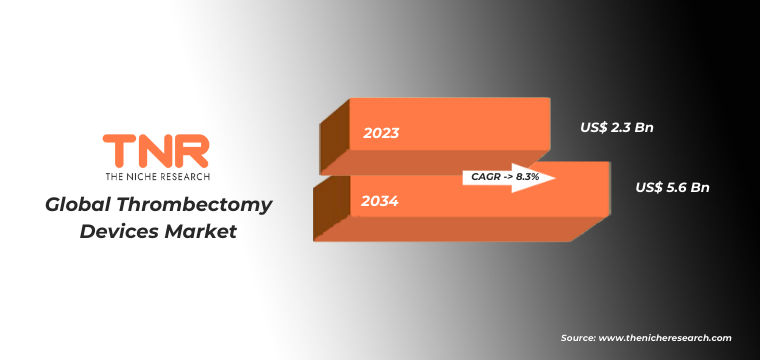
Trends in the Global Thrombectomy Devices Market
- Integration of AI and Robotics: AI algorithms enhance procedural precision by providing real-time imaging analysis and predicting optimal pathways for clot removal, significantly improving patient outcomes. Robotics offer enhanced dexterity and stability, allowing for more intricate and controlled movements during procedures. This synergy between AI and robotics reduces procedural times and minimizes complications, fostering higher adoption rates among healthcare providers. As technology advances, the development of fully automated thrombectomy systems is anticipated, which could further streamline operations and reduce the reliance on human expertise. This trend not only boosts procedural success rates but also attracts substantial investments in R&D, driving market growth.
- Development of Portable and User-Friendly Devices: The demand for portable and user-friendly thrombectomy devices is gaining momentum, driven by the need for efficient and accessible treatment options in diverse healthcare settings. These compact devices are designed for ease of use, enabling quick deployment in emergency situations, such as ambulances or remote locations. Enhanced portability facilitates widespread adoption across smaller clinics and outpatient settings, expanding the market reach. User-friendly interfaces and simplified operational mechanisms reduce the learning curve for medical practitioners, promoting broader utilization. This trend aligns with the growing emphasis on decentralized healthcare and point-of-care solutions, addressing the needs of an aging population and increasing incidences of thromboembolic conditions worldwide.
Mechanical thrombectomy devices by type category has emerged as a dominant segment in the global thrombectomy devices market due to their efficacy in rapidly restoring blood flow and minimizing tissue damage. These devices, including aspiration, fragmentation, and rhseolytic thrombectomy tools, offer precise clot removal with minimal invasiveness, reducing recovery times and procedural risks. Technological advancements, such as improved catheter designs and integration with real-time imaging, enhance their effectiveness and ease of use. The increasing prevalence of ischemic strokes and peripheral vascular diseases, coupled with a rising preference for minimally invasive procedures, further drives demand. As healthcare systems worldwide prioritize swift and efficient treatments, mechanical thrombectomy devices continue to gain traction, solidifying their market dominance.
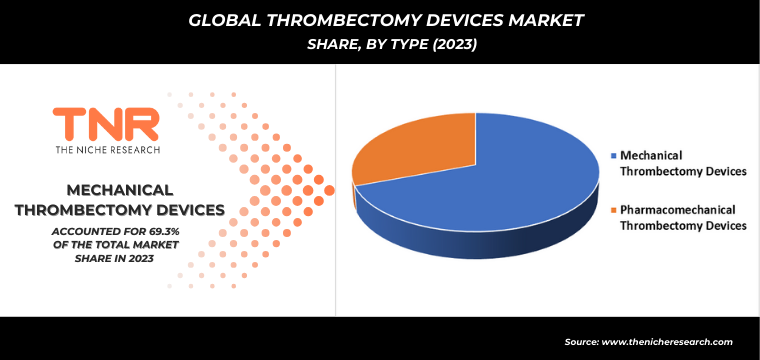
In 2023, neurovascular disease segment solidified its position as the second-largest application category within the global thrombectomy devices market. This growth is primarily driven by the increasing incidence of ischemic strokes and advancements in neurointerventional techniques. The efficacy of mechanical thrombectomy in swiftly restoring cerebral blood flow and improving patient outcomes has garnered widespread adoption. Enhanced imaging technologies and the development of specialized neurovascular devices have further bolstered this segment. Additionally, rising awareness and early diagnosis of stroke symptoms have contributed to the heightened demand for thrombectomy procedures, reinforcing the neurovascular segment’s significant market share.
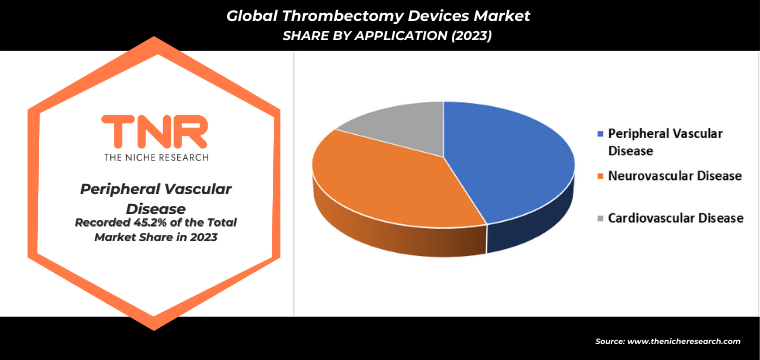
By end user, specialty clinics segment is anticipated to grow fastest over the forecast timeline in global thrombectomy devices market. This growth is driven by the increasing preference for specialized, patient-focused care in treating thromboembolic conditions. Specialty clinics offer advanced, minimally invasive procedures with shorter waiting times and personalized treatment plans, attracting patients seeking efficient and effective care. The rise in outpatient procedures and advancements in portable thrombectomy devices make it feasible for these clinics to adopt cutting-edge technologies. Additionally, specialty clinics often provide cost-effective alternatives to hospital-based treatments, appealing to a broader patient base. This trend aligns with the growing emphasis on specialized healthcare services, propelling the rapid expansion of this segment.
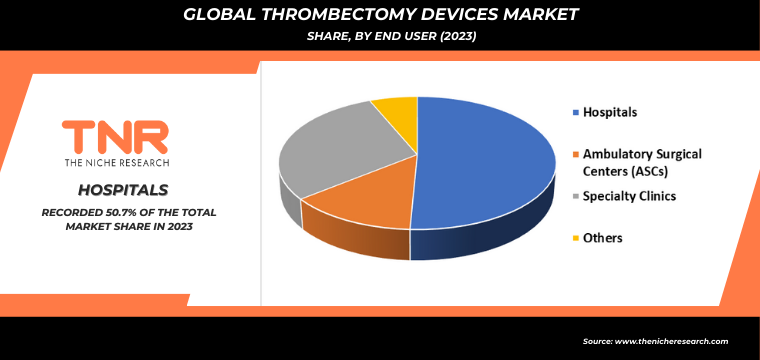
In 2023, North America solidified its dominance in the global thrombectomy devices market, contributing a revenue share of 36.2%. This dominance is attributed to the region’s advanced healthcare infrastructure, high prevalence of thromboembolic diseases, and significant investments in medical technology research and development. The presence of leading market players and favorable reimbursement policies further boost market growth. Increased awareness and early diagnosis of conditions like ischemic stroke drive demand for thrombectomy procedures. Additionally, continuous advancements in minimally invasive techniques and strong support from regulatory bodies ensure North America’s leading position in the thrombectomy devices market, reflecting its robust healthcare ecosystem and innovation capacity.
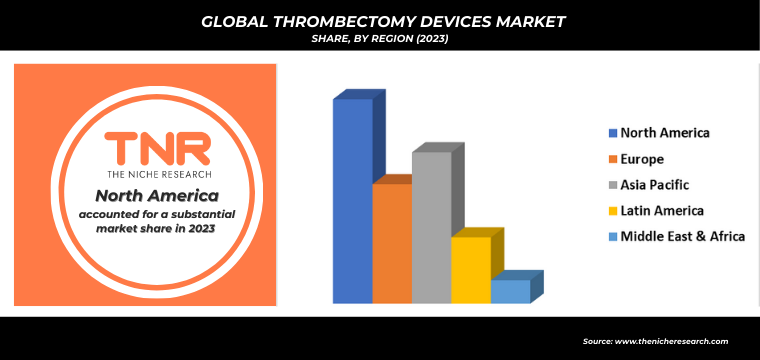
Competitive Landscape
Some of the players operating in the thrombectomy devices market are
- Abbott Laboratories
- Acandis GmbH
- Boston Scientific Corporation
- BTG International Ltd. (acquired by Boston Scientific)
- Capture Vascular, Inc.
- Control Medical Technology, LLC
- Cook Medical
- Johnson & Johnson
- Medtronic
- Merit Medical Systems, Inc.
- MicroVention, Inc. (subsidiary of Terumo Corporation)
- Penumbra Europe GmbH
- Phenox GmbH
- Stryker Corporation
- Teleflex Incorporated
- Terumo Corporation
- Other Industry Participants
Global Thrombectomy Devices Market Scope
| Report Specifications | Details |
| Market Revenue in 2023 | US$ 2.3 Bn |
| Market Size Forecast by 2034 | US$ 5.6 Bn |
| Growth Rate (CAGR) | 8.3% |
| Historic Data | 2016 – 2022 |
| Base Year for Estimation | 2023 |
| Forecast Period | 2024 – 2034 |
| Report Inclusions | Market Size & Estimates, Market Dynamics, Competitive Scenario, Trends, Growth Factors, Market Determinants, Key Investment Segmentation, Product/Service/Solutions Benchmarking |
| Segments Covered | By Type, By Application, By End User, By Region |
| Regions Covered | North America, Europe, Asia Pacific, Middle East & Africa, Latin America |
| Countries Covered | U.S., Canada, Mexico, Rest of North America, France, The UK, Spain, Germany, Italy, Nordic Countries (Denmark, Finland, Iceland, Sweden, Norway), Benelux Union (Belgium, The Netherlands, Luxembourg), Rest of Europe, China, Japan, India, New Zealand, Australia, South Korea, Southeast Asia (Indonesia, Thailand, Malaysia, Singapore, Rest of Southeast Asia), Rest of Asia Pacific, Saudi Arabia, UAE, Egypt, Kuwait, South Africa, Rest of Middle East & Africa, Brazil, Argentina, Rest of Latin America |
| Key Players | Abbott Laboratories, Acandis GmbH, Boston Scientific Corporation, BTG International Ltd. (acquired by Boston Scientific), Capture Vascular, Inc., Control Medical Technology, LLC, Cook Medical, Johnson & Johnson, Medtronic, Merit Medical Systems, Inc., MicroVention, Inc. (subsidiary of Terumo Corporation), Penumbra Europe GmbH, Phenox GmbH, Stryker Corporation, Teleflex Incorporated, Terumo Corporation |
| Customization Scope | Customization allows for the inclusion/modification of content pertaining to geographical regions, countries, and specific market segments. |
| Pricing & Procurement Options | Explore purchase options tailored to your specific research requirements |
| Contact Details | Consult With Our Expert
Japan (Toll-Free): +81 663-386-8111 South Korea (Toll-Free): +82-808- 703-126 Saudi Arabia (Toll-Free): +966 800-850-1643 United Kingdom: +44 753-710-5080 United States: +1 302-232-5106 E-mail: askanexpert@thenicheresearch.com
|
Global Thrombectomy Devices Market
By Type
- Mechanical Thrombectomy Devices
- Aspiration Thrombectomy Devices
- Fragmentation Thrombectomy Devices
- Rheolytic Thrombectomy Devices
- Ultrasonic Thrombectomy Devices
- Pharmacomechanical Thrombectomy Devices
- Catheter-Directed Thrombolysis
- Ultrasound-Assisted Thrombolysis
By Application
- Peripheral Vascular Disease
- Deep Vein Thrombosis
- Pulmonary Embolism
- Others
- Neurovascular Disease
- Ischemic Stroke
- Others
- Cardiovascular Disease
- Myocardial Infarction
- Others
By End User
- Hospitals
- Ambulatory Surgical Centers (ASCs)
- Specialty Clinics
- Others
By Region
- North America (U.S., Canada, Mexico, Rest of North America)
- Europe (France, The UK, Spain, Germany, Italy, Nordic Countries (Denmark, Finland, Iceland, Sweden, Norway), Benelux Union (Belgium, The Netherlands, Luxembourg), Rest of Europe)
- Asia Pacific (China, Japan, India, New Zealand, Australia, South Korea, Southeast Asia (Indonesia, Thailand, Malaysia, Singapore, Rest of Southeast Asia), Rest of Asia Pacific)
- Middle East & Africa (Saudi Arabia, UAE, Egypt, Kuwait, South Africa, Rest of Middle East & Africa)
- Latin America (Brazil, Argentina, Rest of Latin America)
Report Layout:
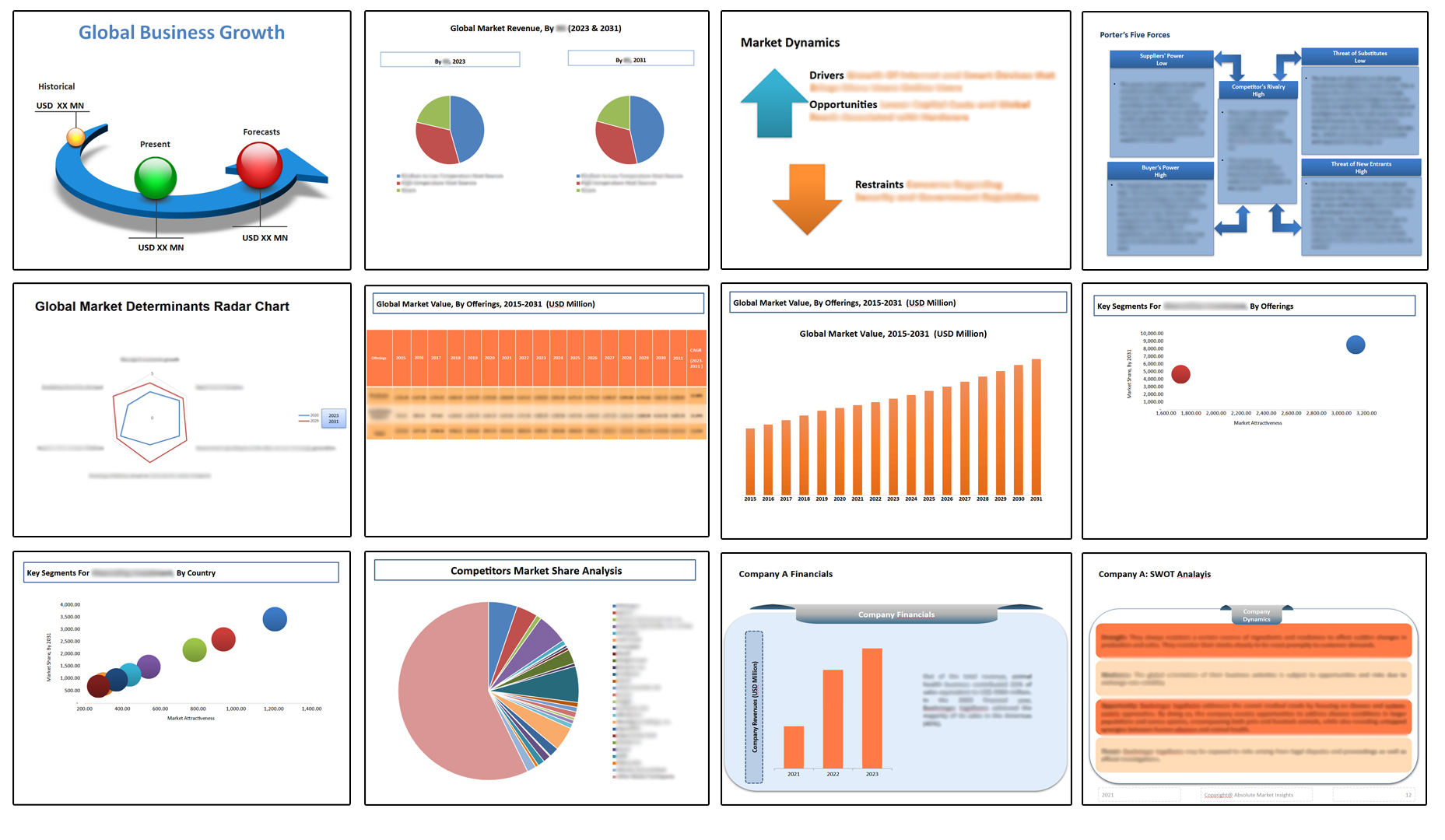
Table of Contents
Note: This ToC is tentative and can be changed according to the research study conducted during the course of report completion.
**Exclusive for Multi-User and Enterprise User.
Report Summary
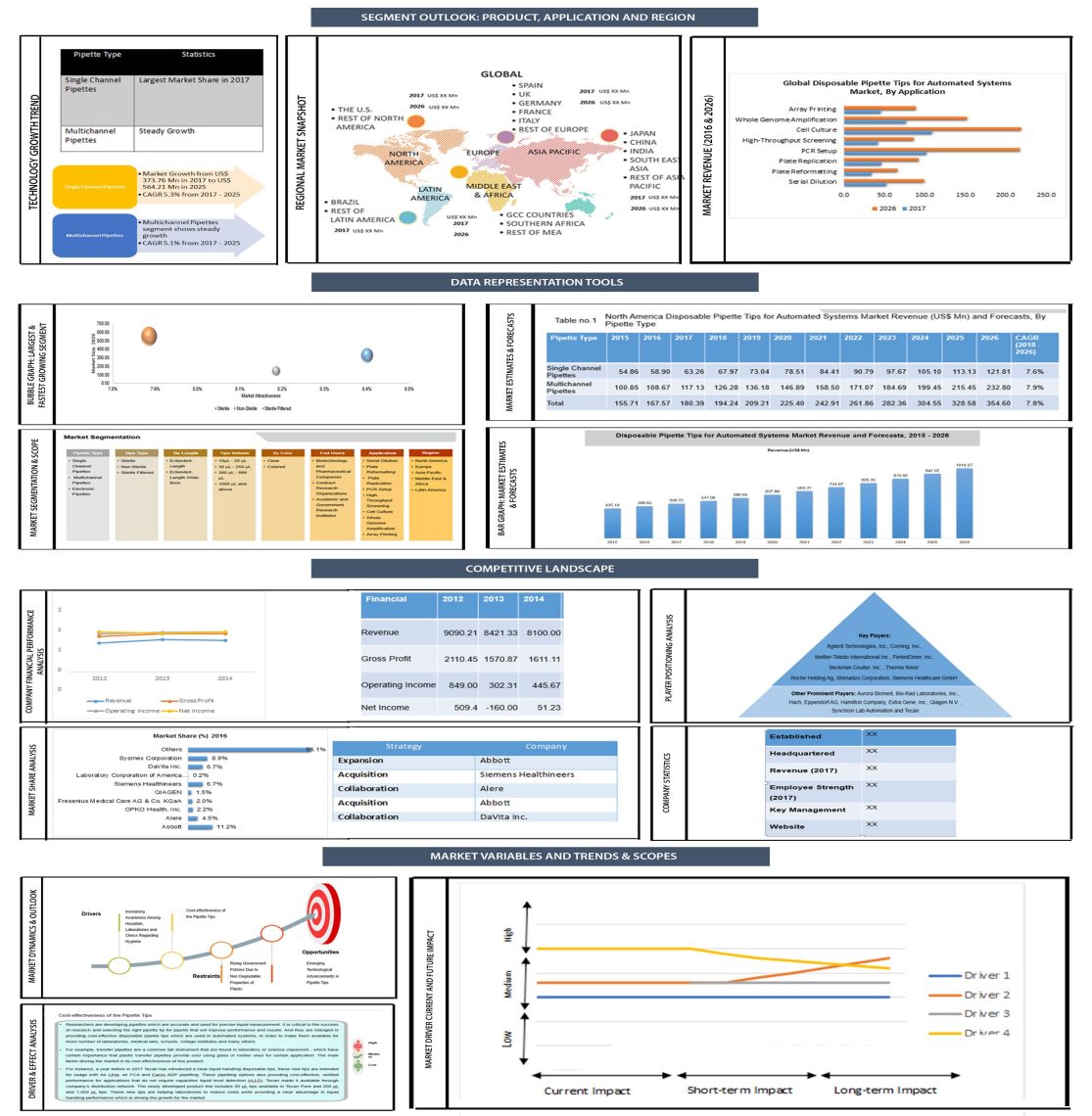
Disclaimer
Global Thrombectomy Devices Market
By Type
- Mechanical Thrombectomy Devices
- Aspiration Thrombectomy Devices
- Fragmentation Thrombectomy Devices
- Rheolytic Thrombectomy Devices
- Ultrasonic Thrombectomy Devices
- Pharmacomechanical Thrombectomy Devices
- Catheter-Directed Thrombolysis
- Ultrasound-Assisted Thrombolysis
By Application
- Peripheral Vascular Disease
- Deep Vein Thrombosis
- Pulmonary Embolism
- Others
- Neurovascular Disease
- Ischemic Stroke
- Others
- Cardiovascular Disease
- Myocardial Infarction
- Others
By End User
- Hospitals
- Ambulatory Surgical Centers (ASCs)
- Specialty Clinics
- Others
By Region
- North America (U.S., Canada, Mexico, Rest of North America)
- Europe (France, The UK, Spain, Germany, Italy, Nordic Countries (Denmark, Finland, Iceland, Sweden, Norway), Benelux Union (Belgium, The Netherlands, Luxembourg), Rest of Europe)
- Asia Pacific (China, Japan, India, New Zealand, Australia, South Korea, Southeast Asia (Indonesia, Thailand, Malaysia, Singapore, Rest of Southeast Asia), Rest of Asia Pacific)
- Middle East & Africa (Saudi Arabia, UAE, Egypt, Kuwait, South Africa, Rest of Middle East & Africa)
- Latin America (Brazil, Argentina, Rest of Latin America)
The Niche Research approach encompasses both primary and secondary research methods to provide comprehensive insights. While primary research is the cornerstone of our studies, we also incorporate secondary research sources such as company annual reports, premium industry databases, press releases, industry journals, and white papers.
Within our primary research, we actively engage with various industry stakeholders, conducting paid interviews and surveys. Our meticulous analysis extends to every market participant in major countries, allowing us to thoroughly examine their portfolios, calculate market shares, and segment revenues.
Our data collection primarily focuses on individual countries within our research scope, enabling us to estimate regional market sizes. Typically, we employ a bottom-up approach, meticulously tracking trends in different countries. We analyze growth drivers, constraints, technological innovations, and opportunities for each country, ultimately arriving at regional figures.Our process begins by examining the growth prospects of each country. Building upon these insights, we project growth and trends for the entire region. Finally, we utilize our proprietary model to refine estimations and forecasts.
Our data validation standards are integral to ensuring the reliability and accuracy of our research findings. Here’s a breakdown of our data validation processes and the stakeholders we engage with during our primary research:
- Supply Side Analysis: We initiate a supply side analysis by directly contacting market participants, through telephonic interviews and questionnaires containing both open-ended and close-ended questions. We gather information on their portfolios, segment revenues, developments, and growth strategies.
- Demand Side Analysis: To gain insights into adoption trends and consumer preferences, we reach out to target customers and users (non-vendors). This information forms a vital part of the qualitative analysis section of our reports, covering market dynamics, adoption trends, consumer behavior, spending patterns, and other related aspects.
- Consultant Insights: We tap into the expertise of our partner consultants from around the world to obtain their unique viewpoints and perspectives. Their insights contribute to a well-rounded understanding of the markets under investigation.
- In-House Validation: To ensure data accuracy and reliability, we conduct cross-validation of data points and information through our in-house team of consultants and utilize advanced data modeling tools for thorough verification.
The forecasts we provide are based on a comprehensive assessment of various factors, including:
- Market Trends and Past Performance (Last Five Years): We accurately analyze market trends and performance data from preceding five years to identify historical patterns and understand the market’s evolution.
- Historical Performance and Growth of Market Participants: We assess the historical performance and growth trajectories of key market participants. This analysis provides insights into the competitive landscape and individual company strategies.
- Market Determinants Impact Analysis (Next Eight Years): We conduct a rigorous analysis of the factors that are projected to influence the market over the next eight years. This includes assessing both internal and external determinants that can shape market dynamics.
- Drivers and Challenges for the Forecast Period:Identify the factors expected to drive market growth during the forecast period, as well as the challenges that the industry may face. This analysis aids in deriving an accurate growth rate projection.
- New Acquisitions, Collaborations, or Partnerships: We keep a close watch on any new acquisitions, collaborations, or partnerships within the industry. These developments can have a significant impact on market dynamics and competitiveness.
- Macro and Micro Factors Analysis:A thorough examination of both macro-level factors (e.g., economic trends, regulatory changes) and micro-level factors (e.g., technological advancements, consumer preferences) that may influence the market during the forecast period.
- End-User Sentiment Analysis: To understand the market from the end-user perspective, we conduct sentiment analysis. This involves assessing the sentiment, preferences, and feedback of the end-users, which can provide valuable insights into market trends.
- Perspective of Primary Participants: Insights gathered directly from primary research participants play a crucial role in shaping our forecasts. Their perspectives and experiences provide valuable qualitative data.
- Year-on-Year Growth Trend: We utilize a year-on-year growth trend based on historical market growth and expected future trends. This helps in formulating our growth projections, aligning them with the market’s historical performance.
Research process adopted by TNR involves multiple stages, including data collection, validation, quality checks, and presentation. It’s crucial that the data and information we provide add value to your existing market understanding and expertise. We have also established partnerships with business consulting, research, and survey organizations across regions and globally to collaborate on regional analysis and data validation, ensuring the highest level of accuracy and reliability in our reports.









